

Compact Muon Solenoid
LHC, CERN
| CMS-SMP-18-014 ; CERN-EP-2022-088 | ||
| Precision measurement of the Z boson invisible width in pp collisions at $\sqrt{s} = $ 13 TeV | ||
| CMS Collaboration | ||
| 14 June 2022 | ||
| Phys. Lett. B 842 (2023) 137563 | ||
| Abstract: A precise measurement of the invisible width of the Z boson produced in proton-proton collisions at a center-of-mass energy of 13 TeV is presented using data recorded by the CMS experiment at the LHC, corresponding to an integrated luminosity of 36.3 fb$^{-1}$. The result is obtained from a simultaneous fit to kinematic distributions for two data samples of Z boson plus jets: one dominated by Z boson decays to invisible particles and the other by Z boson decays to muon and electron pairs. The invisible width is measured to be 523 $\pm$ 3 (stat) $\pm$ 16 (syst) MeV. This result is the first precise measurement of the invisible width of the Z boson at a hadron collider, and is the single most precise direct measurement to date, competitive with the combined result of the direct measurements from the LEP experiments. | ||
| Links: e-print arXiv:2206.07110 [hep-ex] (PDF) ; CDS record ; inSPIRE record ; HepData record ; Physics Briefing ; CADI line (restricted) ; | ||
| Figures | |
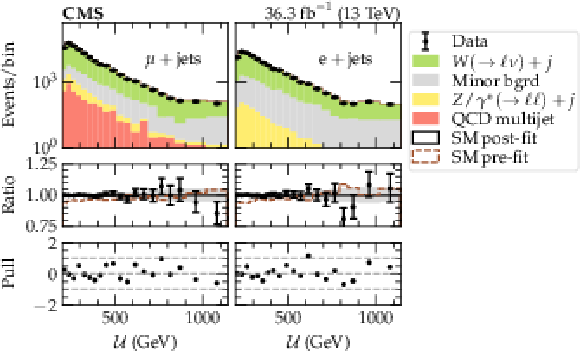
png pdf |
Figure 1:
Distributions of ${\mathcal {U}}$ in the regions of $\mu$+jets (left) and e+jets (right). Ratios are taken of the data with respect to both the SM post-fit and SM pre-fit results from a simultaneous likelihood fit is performed to assess the consistency between the $\mu$+jets and e+jets channels. Pull is the difference between the data and the SM post-fit results, normalized by their uncertainties summed in quadrature. The 'Minor' background includes the sum of all the contributions from processes such as diboson events, top pair production, and single top production. |
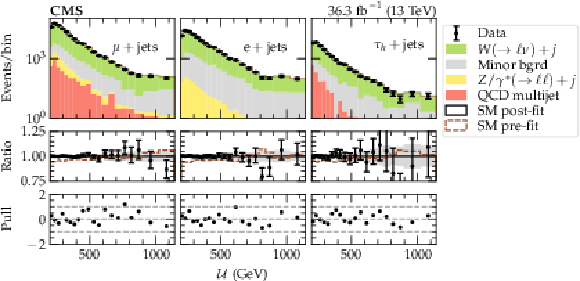
png pdf |
Figure 2:
Distributions of ${\mathcal {U}}$ in the regions of $\mu$+jets (left), e+jets (center), and $\tau_{\text{h}}$+jets (right). Ratios are taken of the data with respect to both the SM post-fit and SM pre-fit results from a likelihood fit performed to verify the consistency between the combined $\mu$+jets and e+jets region with the $\tau_{\text{h}}$+jets region. The pulls are the difference between the data and the SM post-fit results, normalized by their uncertainties summed in quadrature. The 'Minor' background includes the sum of all the contributions from processes such as diboson events, top pair production, and single top production. |
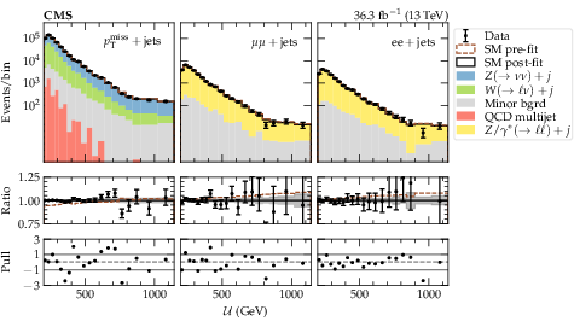
png pdf |
Figure 3:
Distribution of ${\mathcal {U}}$ for the $p_{\text {T}}^{\text {miss}}$+jets (left), ${{\mathrm {Z}} /\gamma^{*} \to \mu \mu}$ (center), and ${{\mathrm {Z}} /\gamma^{*} \to \mathrm{ee}}$ (right) regions. Ratios are taken of the data with respect to both the SM post-fit and SM pre-fit results. The pulls are the difference between the data and the SM post-fit results, normalized by their uncertainties summed in quadrature. The 'Minor' background includes the sum of all the contributions from processes such as diboson events, top pair production, single top production that are determined from simulation. |
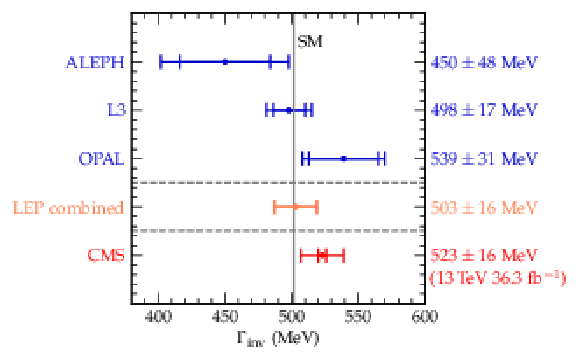
png pdf |
Figure 4:
Direct measurements of the Z invisible width by the LEP experiments and the result from the CMS experiment presented here. Also shown is the prediction from the SM. The inner (outer) error bars show the statistical (total) uncertainty. |
| Tables | |
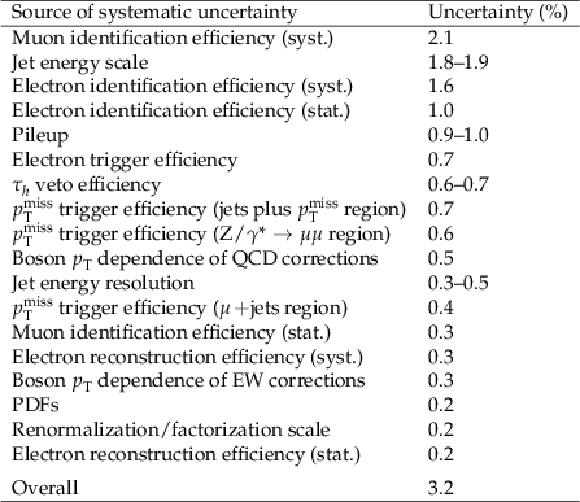
png pdf |
Table 1:
Relative uncertainties (in %) on the final measurement from different sources. |
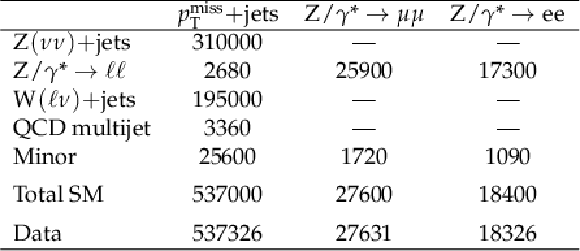
png pdf |
Table 2:
SM post-fit predictions for the $p_{\text {T}}^{\text {miss}}$+jets, ${{\mathrm {Z}} /\gamma^{*} \to \mu \mu}$, and ${{\mathrm {Z}} /\gamma^{*} \to \mathrm{ee}}$ regions and the total number of events measured in data. |
| Summary |
| In summary, this Letter presents the first precise measurement of the invisible width (${\Gamma_{\text{inv}}} $) of the Z boson at a hadron collider. The measurement is performed using proton-proton collisions at $\sqrt{s} = $ 13 TeV and data corresponding to an integrated luminosity of 36.3 fb$^{-1}$ recorded with the CMS detector, yielding a result of ${\Gamma_{\text{inv}}} =$ 523 $\pm$ 3 (stat) $\pm$ 16 (syst) MeV. It represents the single most precise direct measurement of ${\Gamma_{\text{inv}}}$ to date and is competitive with the combined direct measurement from LEP and compatible with the value expected in the standard model. |
| References | ||||
| 1 | CMS Collaboration | Search for new particles in events with energetic jets and large missing transverse momentum in proton-proton collisions at $ \sqrt{s} $ = 13 TeV | JHEP 11 (2021) 153 | CMS-EXO-20-004 2107.13021 |
| 2 | OPAL Collaboration | Measurement of single photon production in $ \mathrm{e}^+\mathrm{e}^- $ collisions near the $ \mathrm{Z}^0 $ resonance | Z. Phys. C 65 (1995) 47 | |
| 3 | ALEPH Collaboration | A direct measurement of the invisible width of the Z from single photon counting | PLB 313 (1993) 520 | |
| 4 | L3 Collaboration | Determination of the number of light neutrino species from single photon production at LEP | PLB 431 (1998) 199 | |
| 5 | Particle Data Group, P. A. Zyla et al. | Review of particle physics | Prog. Theor. Exp. Phys. 2020 (2020) 083C01 | |
| 6 | UA2 Collaboration | Measurement of the standard model parameters from a study of W and Z bosons | PLB 186 (1987) 440 | |
| 7 | M. Carena, A. de Gouvea, A. Freitas, and M. Schmitt | Invisible Z boson decays at $ \mathrm{e}^+\mathrm{e}^- $ colliders | PRD 68 (2003) 113007 | hep-ph/0308053 |
| 8 | CMS Collaboration | Precision luminosity measurement in proton-proton collisions at $ \sqrt{s} = $ 13 TeV in 2015 and 2016 at CMS | EPJC 81 (2021) 800 | CMS-LUM-17-003 2104.01927 |
| 9 | CMS Collaboration | HEPData record for this analysis | link | |
| 10 | CMS Collaboration | Measurement of the Z boson differential production cross section using its invisible decay mode (Z $\to \nu\bar{\nu} $) in proton-proton collisions at $ \sqrt{s}= $ 13 TeV | JHEP 05 (2021) 205 | CMS-SMP-18-003 2012.09254 |
| 11 | CMS Collaboration | The CMS trigger system | JINST 12 (2017) P01020 | CMS-TRG-12-001 1609.02366 |
| 12 | CMS Collaboration | The CMS experiment at the CERN LHC | JINST 3 (2008) S08004 | |
| 13 | CMS Collaboration | Particle-flow reconstruction and global event description with the CMS detector | JINST 12 (2017) P10003 | CMS-PRF-14-001 1706.04965 |
| 14 | D. Contardo et al. | Technical proposal for the Phase-II upgrade of the CMS detector | technical report, 2015 link |
|
| 15 | M. Cacciari, G. P. Salam, and G. Soyez | The anti-$ k_{\mathrm{T}} $ jet clustering algorithm | JHEP 04 (2008) 063 | 0802.1189 |
| 16 | M. Cacciari, G. P. Salam, and G. Soyez | FastJet user manual | EPJC 72 (2012) 1896 | 1111.6097 |
| 17 | CMS Collaboration | Jet energy scale and resolution in the CMS experiment in pp collisions at 8 TeV | JINST 12 (2017) P02014 | CMS-JME-13-004 1607.03663 |
| 18 | CMS Collaboration | Performance of reconstruction and identification of $ \tau $ leptons decaying to hadrons and $ \nu_\tau $ in pp collisions at $ \sqrt{s}= $ 13 TeV | JINST 13 (2018) P10005 | CMS-TAU-16-003 1809.02816 |
| 19 | CMS Collaboration | Performance of missing transverse momentum reconstruction in proton-proton collisions at $ \sqrt{s} = $ 13 TeV using the CMS detector | JINST 14 (2019) P07004 | CMS-JME-17-001 1903.06078 |
| 20 | J. Alwall et al. | The automated computation of tree-level and next-to-leading order differential cross sections, and their matching to parton shower simulations | JHEP 07 (2014) 079 | 1405.0301 |
| 21 | T. Sjöstrand et al. | An introduction to PYTHIA 8.2 | Comput. Phys. Commun. 191 (2015) 159 | 1410.3012 |
| 22 | R. Frederix and S. Frixione | Merging meets matching in MC@NLO | JHEP 12 (2012) 061 | 1209.6215 |
| 23 | J. M. Lindert et al. | Precise predictions for V+jets dark matter backgrounds | Eur. Phys. J. C. 77 (2017) 829 | 1705.04664 |
| 24 | N. Kidonakis | Differential and total cross sections for top pair and single top production | in Proceedings, 20th International Workshop on Deep-Inelastic Scattering and Related Subjects, Bonn, 2012 DIS 201 (2012) 831 |
1205.3453 |
| 25 | M. Czakon, P. Fiedler, and A. Mitov | Total top-quark pair-production cross section at hadron colliders through $ {\cal O}(\alpha_S^4) $ | PRL 110 (2013) 252004 | 1303.6254 |
| 26 | P. Nason | A new method for combining NLO QCD with shower Monte Carlo algorithms | JHEP 11 (2004) 040 | hep-ph/0409146 |
| 27 | S. Frixione, P. Nason, and C. Oleari | Matching NLO QCD computations with parton shower simulations: the POWHEG method | JHEP 11 (2007) 070 | 0709.2092 |
| 28 | S. Alioli, P. Nason, C. Oleari, and E. Re | A general framework for implementing NLO calculations in shower Monte Carlo programs: the POWHEG BOX | JHEP 06 (2010) 043 | 1002.2581 |
| 29 | E. Re | Single-top Wt-channel production matched with parton showers using the POWHEG method | Eur. Phys. J. C. 71 (2011) 1547 | 1009.2450 |
| 30 | NNPDF Collaboration | Parton distributions for the LHC Run II | JHEP 04 (2015) 040 | 1410.8849 |
| 31 | CMS Collaboration | Event generator tunes obtained from underlying event and multiparton scattering measurements | Eur. Phys. J. C. 76 (2016) 155 | CMS-GEN-14-001 1512.00815 |
| 32 | GEANT 4 Collaboration | GEANT 4 --- a simulation toolkit | NIM A 506 (2003) 250 | |
| 33 | CMS Collaboration | Electron and photon reconstruction and identification with the CMS experiment at the CERN LHC | JINST 16 (2021) P05014 | CMS-EGM-17-001 2012.06888 |
| 34 | CMS Collaboration | Identification of heavy-flavour jets with the CMS detector in pp collisions at 13 TeV | JINST 13 (2018) P05011 | CMS-BTV-16-002 1712.07158 |
| 35 | CMS Collaboration | Performance of the reconstruction and identification of high-momentum muons in proton-proton collisions at $ \sqrt{s} = $ 13 TeV | JINST 15 (2020) P02027 | CMS-MUO-17-001 1912.03516 |
| 36 | CMS Collaboration | Measurements of differential Z boson production cross sections in proton-proton collisions at $ \sqrt{s} $ = 13 TeV | JHEP 12 (2019) 061 | CMS-SMP-17-010 1909.04133 |
| 37 | ALEPH, DELPHI, L3, OPAL, and SLD Collaborations, LEP Electroweak Working Group, SLD Electroweak Group, and SLD Heavy Flavour Group Collaboration | Precision electroweak measurements on the $ Z $ resonance | Phys. Rept. 427 (2006) 257 | hep-ex/0509008 |

|
Compact Muon Solenoid LHC, CERN |

|

|

|

|

|

|